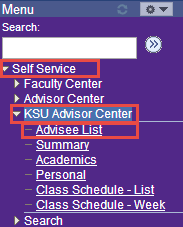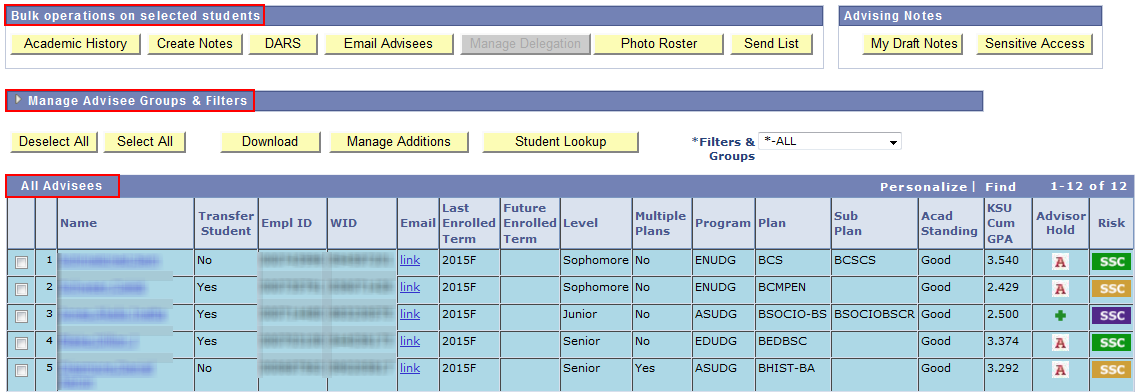Advisees are added to the Advisee list if:
- They are assigned to you as their advisor.
- You manually added them to your list using the Manage Additions function.
- They are delegated by another to an advisor (coming attraction).
Advisees are
displayed in your advisee list using the following considerations:
- An advisee remains in your KSU Advisor Center as long as they are active in the program with which you are associated.
- A student might be associate with you in the KSU Advisor Center in multiple rows due to multiple active programs, plans or subplans.
- If a student is associated to you in more than one row, only one row per student is visible at a time.
- The default visible row for students with multiple rows is determined by the following rules:
- Show ‘Assigned’ rows before ‘Added’ rows.
- Show first row when rows are sorted by program/plan/subplan.
- Rows for a student that are not selected to be visible by default, can be made visible using Advisee Groups and Filters.
Examples
|
Joe Student is active in program ASUDG and plan BHIST-BS and you are assigned as his advisor.
|
When you go to KSU Advisor Center, you see Joe Student, ASUDG, BHIST-BS row.
|
|
Joe Student starts a secondary major in ASUDG/BGEOG-BA.
|
The next time you go to KSU Advisor Center, you see Joe Student, ASUDG, BGEOG-BA. Even though you are the advisor for ASUDG/BHIST-BS, all active ASUDG plans are brought into KSU Advisor Center. The default hides plans that are not alphabetically first.
To see the ASUDG, BHIST-BS row, use Groups & Filters. Create a Filter with BHIST-BS selected from the Plan dropdown list. Select Run Filter.
|
|
Joe Student transfers out of ASUDG and into BAUDG/BACCTG.
|
The next time you go to KSU Advisor Center, Joe Student is not visible. He is no longer active in the program (ASUDG) with which you have an association.
|
|
Jane Student is active in program ASUDG and plan BHIST-BS and you are assigned as her advisor.
|
The next time you go to KSU Advisor Center, you see Jane Student, ASUDG, BHIST-BS row.
|
|
Jane is admitted to Graduate school and becomes active in ASGDG/MHIST.
|
The next time you go to KSU Advisor Center, you see Jane Student, ASUDG, BHIST-BS row.
Because you are not associated with the with this student in ASGDG program, this row is not brought into your KSU Advisor Center.
|
| You add ASGDG for Jane via the Manage Additions functionality. |
The next time you go to KSU Advisor Center, you see Jane Student, ASUDG, BHIST-BS.
Although you added ASGDG in the Manage Additions, the default shows programs that you are officially assigned as an advisor over those that you added via Manage Additions.
To see the ASGDG, MHIST row, Groups & Filters. Create a filter, selecting MHIST from the Plan dropdown list. Select Run Filter.
|
|
Jane completes her BHIST program.
|
Now you see the ASGDG/MHIST row as the default.
|



